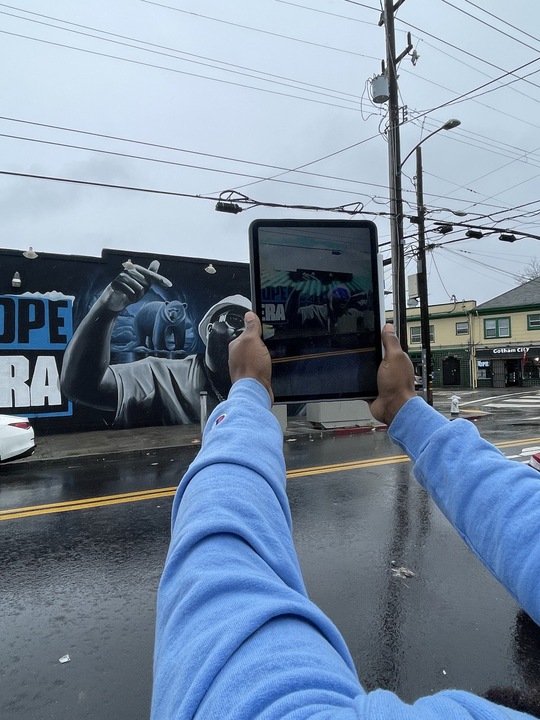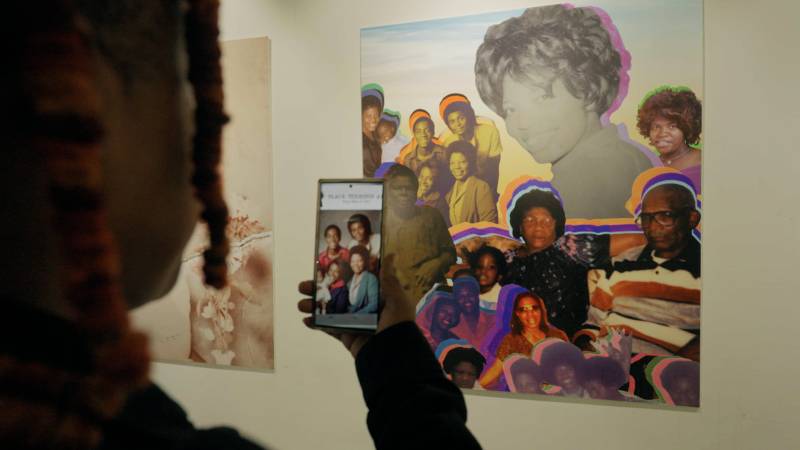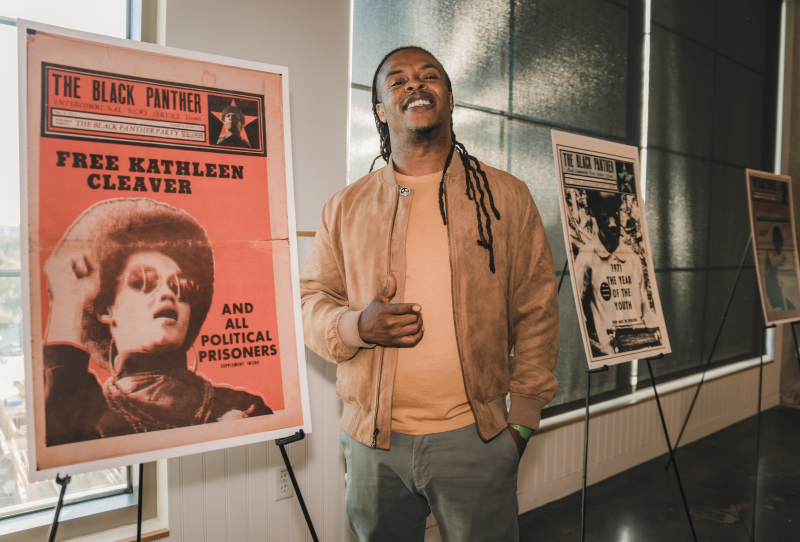At the corner of 45th and Market Street in North Oakland, there’s a fresh mural of hip-hop star and community pillar Mistah F.A.B. Painted by Steven Anderson and DeAndre “Airballin” Drake, F.A.B.’s face is shown surrounded by a color palette of black, white and icy blue, complete with an image of a polar bear — a nod to the neighborhood’s nickname of “the North Pole.” Just a few days after it was painted, in the midst of a winter storm, I stood out there with my friend Damien McDuffie as he held an iPad camera pointed in the direction of the dope new aerosol art.
Black Terminus AR Says New Tech Is for the People

The lens of the camera locked in on the image on the wall, and then the tablet’s screen came to life. F.A.B.’s illustrated head began nodding as he rapped lyrics from his trademark hit, “N.E.W. Oakland.” In reality, the wall wasn’t moving. But on the tablet, the world of augmented reality (AR) created a whole new visual experience.

McDuffie is the founder of Black Terminus AR, and with this app, I’ve seen him work magic on the $20 bill, replacing the image of President Andrew Jackson with Harriet Tubman. I’ve seen him take the painted images of Huey P. Newton and Bobby Seale that adorn the side of a multiple-story building in downtown Oakland, and use his app to bring them to life.
I’ve seen McDuffie do this work a bunch of times, but never learned how to it for myself. That’s because he hasn’t taken the time to teach others this art en masse — until now.
From June 14–16, Black Terminus AR is hosting the Juneteenth Reality Hack in downtown Oakland. During the three-day event, people will have opportunity to learn the ins-and-outs of this technology, and then create augmented reality experiences in minutes by going through project-based workshops.
Attendees will work with groups of artists and culture-keepers, including the Women of the Black Panther Party Mural and Museum, the Bay Area Mural Program, Good Air Studios, The Air Temple Art Space, as well as McDuffie’s AR Museum for the People project, which is a tour of the Black Panther Party murals around Oakland.

“The challenge that we’re giving them,” says McDuffie, “is ‘If this mural is the first frame of a 30-second-to-one-minute scene, what does the rest of the scene look like?’” From there, it’s up to the attendees to learn how to animate the rest of the scene.
Along with learning the platform and working on specific projects, McDuffie says attendees will have a chance to meet a wide range of people who are in the industry, including people who work on the popular Pokémon Go AR app.
But you don’t have to be a tech head to be in the mix. No, instead McDuffie is asking everyday people — especially artists who use tablets and smart phones to communicate — to come out and participate.
McDuffie says his first goal is lowering the barrier to entry: “If we don’t have to know HTML coding to send an email, then we shouldn’t need to know app development to create augmented reality. ”
McDuffie, who holds an MFA from Columbia University, isn’t traditionally trained in this tech. Instead of classrooms and exams, he spent hours at “YouTube University” — and those digital lessons, coupled with a 2019 trip to Asia, inspired his work. Over the past five years he’s done workshops around the globe; just this year he’s visited the Dominican Republic, Denmark and more.
Through all of his studies and travels, one thing has become increasing clear: Artists should be at the forefront of the technology. For one, he says, without artists, you don’t have augmented reality or artificial intelligence to begin with.
Furthermore, he adds, artists stand to make a lot of money in this industry. McDuffie, also a photographer, says before he added the AR element to his images, the most he’d earned from a print was $250. “As soon as I started doing prints with AR, those went for like $2,500,” says McDuffie.
With this in mind, he wants to show artists how digitizing their work can increase their cashflow, and also ease their workflow. McDuffie is transparent and self-effacing about this goal: “If I can create this in like two to three years, without any real art experience beside being a culture maker … imagine what people who have artistic skill can create,” he says. “I see these artists that have way better skills than me, so they should probably be making more money.”
Beyond the money and the ability to create art, McDuffie raises an important point when it comes to the current state of AR’s influence on society. He says that people involved in the early stages of the technology also set the rules on how the technology is used.
McDuffie refers to Huey P. Newton’s essay The Technology Question as a reminder of what’s really at stake.

“[Huey P. Newton] explained that the way that technology is developed, it actually shapes culture,” McDuffie tells me. “So, for the people who were at the forefront of jet propulsion and flying, they were also able to set the policies for how we’re using that.”
He argues that folks who have apprehensions about the influx of AR and AI are actually the people who should be on the frontline of designing and implementing this technology.
“What I’m trying to get people to understand,” says McDuffie, “is that AR and AI, for this to be something that isn’t a detriment to our society… it requires the people who care about those things to be involved.”
The Black Terminus AR Juneteenth Reality Hack will take place June 14–16 in downtown Oakland, based out of the Block Community Hub/Black Cultural Zone (1955 Broadway), with satellite workshops at COMMUNE (1716 Broadway) and the Kapor Center (2148 Broadway). Visit the event website for more details.

